Workplace Discrimination and Fairness
VerifiedAdded on 2020/04/01
|15
|4003
|49
AI Summary
This assignment delves into the complex issue of workplace discrimination. It requires students to examine various aspects, including the historical context, legal frameworks like the Civil Rights Act of 1964, and contemporary examples of discrimination based on race, age, and gender. Students will analyze research findings and case studies to understand the implications of such discrimination for individuals and organizations. The assignment encourages critical thinking about strategies for promoting fairness and equality in the workplace.
Contribute Materials
Your contribution can guide someone’s learning journey. Share your
documents today.

Contemporary Issues
in HRM
HRMT 20030
in HRM
HRMT 20030
Secure Best Marks with AI Grader
Need help grading? Try our AI Grader for instant feedback on your assignments.
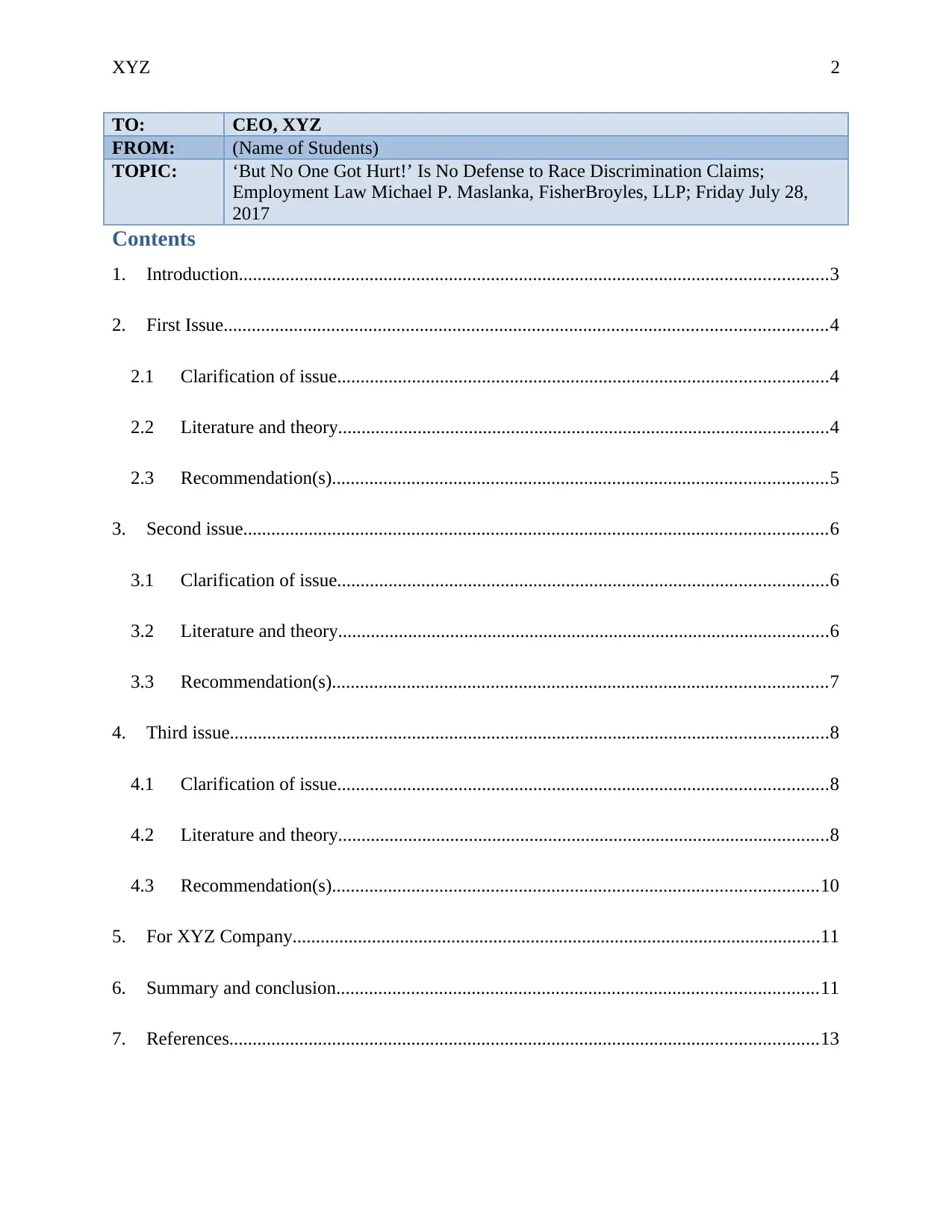
XYZ 2
TO: CEO, XYZ
FROM: (Name of Students)
TOPIC: ‘But No One Got Hurt!’ Is No Defense to Race Discrimination Claims;
Employment Law Michael P. Maslanka, FisherBroyles, LLP; Friday July 28,
2017
Contents
1. Introduction..............................................................................................................................3
2. First Issue.................................................................................................................................4
2.1 Clarification of issue.........................................................................................................4
2.2 Literature and theory.........................................................................................................4
2.3 Recommendation(s)..........................................................................................................5
3. Second issue.............................................................................................................................6
3.1 Clarification of issue.........................................................................................................6
3.2 Literature and theory.........................................................................................................6
3.3 Recommendation(s)..........................................................................................................7
4. Third issue................................................................................................................................8
4.1 Clarification of issue.........................................................................................................8
4.2 Literature and theory.........................................................................................................8
4.3 Recommendation(s)........................................................................................................10
5. For XYZ Company.................................................................................................................11
6. Summary and conclusion.......................................................................................................11
7. References..............................................................................................................................13
TO: CEO, XYZ
FROM: (Name of Students)
TOPIC: ‘But No One Got Hurt!’ Is No Defense to Race Discrimination Claims;
Employment Law Michael P. Maslanka, FisherBroyles, LLP; Friday July 28,
2017
Contents
1. Introduction..............................................................................................................................3
2. First Issue.................................................................................................................................4
2.1 Clarification of issue.........................................................................................................4
2.2 Literature and theory.........................................................................................................4
2.3 Recommendation(s)..........................................................................................................5
3. Second issue.............................................................................................................................6
3.1 Clarification of issue.........................................................................................................6
3.2 Literature and theory.........................................................................................................6
3.3 Recommendation(s)..........................................................................................................7
4. Third issue................................................................................................................................8
4.1 Clarification of issue.........................................................................................................8
4.2 Literature and theory.........................................................................................................8
4.3 Recommendation(s)........................................................................................................10
5. For XYZ Company.................................................................................................................11
6. Summary and conclusion.......................................................................................................11
7. References..............................................................................................................................13

XYZ 3
1. Introduction
Discrimination refers to any sort of disparity which takes place between different people
on basis of reasons like gender, cast, race, religion, creed, age, disability, religious belief, sexual
orientation, faith, or colour of an individual. It is an unfavourable or a favourable treatment
against a person which is discriminatory in nature (Sargeant, 2016). Discrimination in
workplaces is unfortunately a common parlance. This makes it necessary for big companies,
particularly XYZ to keep a strict eye on the chances of occurrence of such incidents which
involve discrimination, as it is not only unethical, but is also unlawful (Becker, 2010).
The news story which featured online highlighted the classic discrimination which took
place in the matter of Emma Lacy. In this news report, even though there was no direct or
apparent discrimination, an indirect discrimination was indeed suffered by Emma based on her
skin colour, which is enough to show that Emma had been subjected to racial discrimination
(Maslanka, 2017). In this case, there were certain key issues which were highlighted which have
to be effectively addressed by Tesco for making certain that there are proper discrimination
management systems installed in place. The key highlights which were presented from this case
study were the oral/ written discrimination based on the race, the unprofessional usage of the
position in order to avoid the potential implications for such racism and the irrational termination
based on the race of the employee.
In the following parts, the key issues which were highlighted through the case study have
been highlighted. This has been done to draw some recommendations for XYZ, which can help
the company in staying away from such incidents, and where they take place, in effectively
dealing with them.
1. Introduction
Discrimination refers to any sort of disparity which takes place between different people
on basis of reasons like gender, cast, race, religion, creed, age, disability, religious belief, sexual
orientation, faith, or colour of an individual. It is an unfavourable or a favourable treatment
against a person which is discriminatory in nature (Sargeant, 2016). Discrimination in
workplaces is unfortunately a common parlance. This makes it necessary for big companies,
particularly XYZ to keep a strict eye on the chances of occurrence of such incidents which
involve discrimination, as it is not only unethical, but is also unlawful (Becker, 2010).
The news story which featured online highlighted the classic discrimination which took
place in the matter of Emma Lacy. In this news report, even though there was no direct or
apparent discrimination, an indirect discrimination was indeed suffered by Emma based on her
skin colour, which is enough to show that Emma had been subjected to racial discrimination
(Maslanka, 2017). In this case, there were certain key issues which were highlighted which have
to be effectively addressed by Tesco for making certain that there are proper discrimination
management systems installed in place. The key highlights which were presented from this case
study were the oral/ written discrimination based on the race, the unprofessional usage of the
position in order to avoid the potential implications for such racism and the irrational termination
based on the race of the employee.
In the following parts, the key issues which were highlighted through the case study have
been highlighted. This has been done to draw some recommendations for XYZ, which can help
the company in staying away from such incidents, and where they take place, in effectively
dealing with them.

XYZ 4
2. First Issue
2.1 Clarification of issue
One of the key issues which were raised in this new story was the oral/ written
discrimination based on the race. The news story highlighted that Emma had been subjected to
oral racial discrimination as her supervisor deemed her as a “Black Matriarch” which clearly
depicts the racist mind of the supervisor. It was pretty clear that the supervisor deemed her as
racially unbearable and that she was willing to initiate legal actions against her supervisor for the
unprofessional behaviour undertaken by him (Maslanka, 2017).
2.2 Literature and theory
Racial discrimination has been defined by Offermann et al (2014) as a type of segregation
which takes place in an organization and which is majorly based on the racial background or the
skin colour of such individual. They further believed that such discrimination discourages the
employees in a major way which also impacts their overall performance. In the opinion of
Barnes et al. (2008) racial discrimination has major consequences, which includes having a
negative impact over the physical, psychological, as well as, over the work outcomes. Wilson
(2005) observed that the Black workers having same credentials as white workers were
dismissed from their jobs 33% more than the white counterparts.
Settles, Buchanan and Yap (2010) were of the view that at times, the employees who do
not perform well are given an artificial lift so that their poor performance is overlooked. In their
view, this results in the decisions regarding promotion and retention being impacted. The use of
terminology like ‘matriarch’ or ‘mammy’ was seen as a major stereotyping against black women
2. First Issue
2.1 Clarification of issue
One of the key issues which were raised in this new story was the oral/ written
discrimination based on the race. The news story highlighted that Emma had been subjected to
oral racial discrimination as her supervisor deemed her as a “Black Matriarch” which clearly
depicts the racist mind of the supervisor. It was pretty clear that the supervisor deemed her as
racially unbearable and that she was willing to initiate legal actions against her supervisor for the
unprofessional behaviour undertaken by him (Maslanka, 2017).
2.2 Literature and theory
Racial discrimination has been defined by Offermann et al (2014) as a type of segregation
which takes place in an organization and which is majorly based on the racial background or the
skin colour of such individual. They further believed that such discrimination discourages the
employees in a major way which also impacts their overall performance. In the opinion of
Barnes et al. (2008) racial discrimination has major consequences, which includes having a
negative impact over the physical, psychological, as well as, over the work outcomes. Wilson
(2005) observed that the Black workers having same credentials as white workers were
dismissed from their jobs 33% more than the white counterparts.
Settles, Buchanan and Yap (2010) were of the view that at times, the employees who do
not perform well are given an artificial lift so that their poor performance is overlooked. In their
view, this results in the decisions regarding promotion and retention being impacted. The use of
terminology like ‘matriarch’ or ‘mammy’ was seen as a major stereotyping against black women
Secure Best Marks with AI Grader
Need help grading? Try our AI Grader for instant feedback on your assignments.
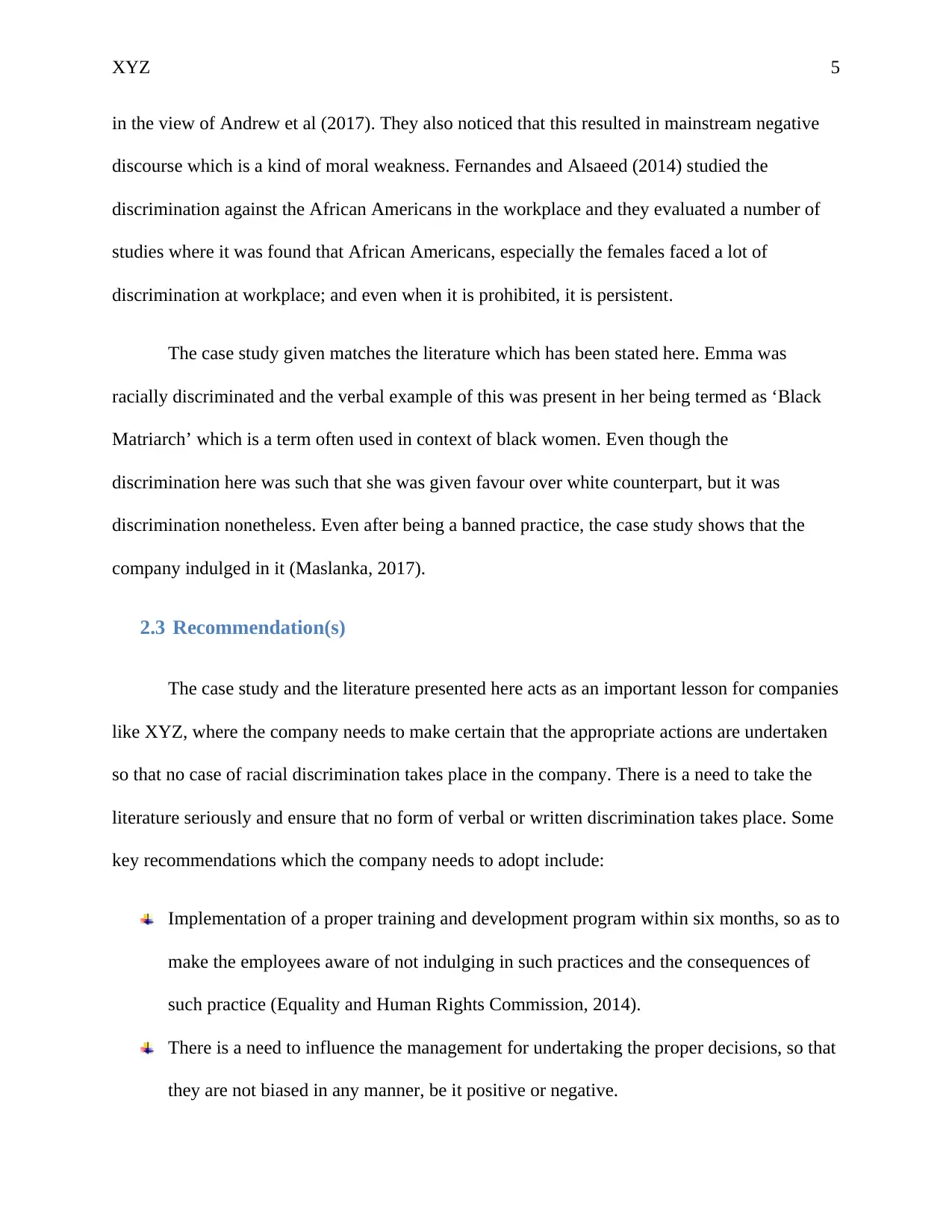
XYZ 5
in the view of Andrew et al (2017). They also noticed that this resulted in mainstream negative
discourse which is a kind of moral weakness. Fernandes and Alsaeed (2014) studied the
discrimination against the African Americans in the workplace and they evaluated a number of
studies where it was found that African Americans, especially the females faced a lot of
discrimination at workplace; and even when it is prohibited, it is persistent.
The case study given matches the literature which has been stated here. Emma was
racially discriminated and the verbal example of this was present in her being termed as ‘Black
Matriarch’ which is a term often used in context of black women. Even though the
discrimination here was such that she was given favour over white counterpart, but it was
discrimination nonetheless. Even after being a banned practice, the case study shows that the
company indulged in it (Maslanka, 2017).
2.3 Recommendation(s)
The case study and the literature presented here acts as an important lesson for companies
like XYZ, where the company needs to make certain that the appropriate actions are undertaken
so that no case of racial discrimination takes place in the company. There is a need to take the
literature seriously and ensure that no form of verbal or written discrimination takes place. Some
key recommendations which the company needs to adopt include:
Implementation of a proper training and development program within six months, so as to
make the employees aware of not indulging in such practices and the consequences of
such practice (Equality and Human Rights Commission, 2014).
There is a need to influence the management for undertaking the proper decisions, so that
they are not biased in any manner, be it positive or negative.
in the view of Andrew et al (2017). They also noticed that this resulted in mainstream negative
discourse which is a kind of moral weakness. Fernandes and Alsaeed (2014) studied the
discrimination against the African Americans in the workplace and they evaluated a number of
studies where it was found that African Americans, especially the females faced a lot of
discrimination at workplace; and even when it is prohibited, it is persistent.
The case study given matches the literature which has been stated here. Emma was
racially discriminated and the verbal example of this was present in her being termed as ‘Black
Matriarch’ which is a term often used in context of black women. Even though the
discrimination here was such that she was given favour over white counterpart, but it was
discrimination nonetheless. Even after being a banned practice, the case study shows that the
company indulged in it (Maslanka, 2017).
2.3 Recommendation(s)
The case study and the literature presented here acts as an important lesson for companies
like XYZ, where the company needs to make certain that the appropriate actions are undertaken
so that no case of racial discrimination takes place in the company. There is a need to take the
literature seriously and ensure that no form of verbal or written discrimination takes place. Some
key recommendations which the company needs to adopt include:
Implementation of a proper training and development program within six months, so as to
make the employees aware of not indulging in such practices and the consequences of
such practice (Equality and Human Rights Commission, 2014).
There is a need to influence the management for undertaking the proper decisions, so that
they are not biased in any manner, be it positive or negative.
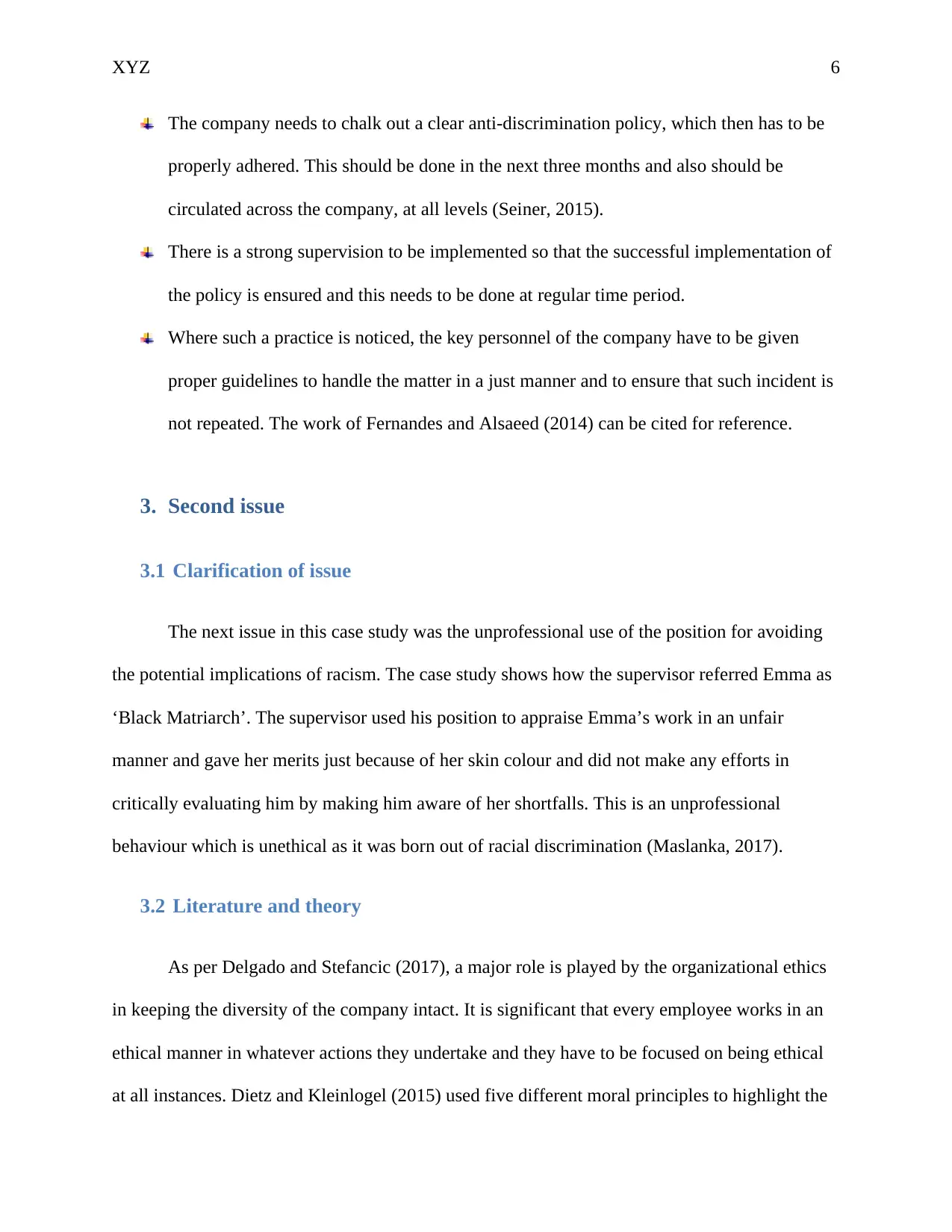
XYZ 6
The company needs to chalk out a clear anti-discrimination policy, which then has to be
properly adhered. This should be done in the next three months and also should be
circulated across the company, at all levels (Seiner, 2015).
There is a strong supervision to be implemented so that the successful implementation of
the policy is ensured and this needs to be done at regular time period.
Where such a practice is noticed, the key personnel of the company have to be given
proper guidelines to handle the matter in a just manner and to ensure that such incident is
not repeated. The work of Fernandes and Alsaeed (2014) can be cited for reference.
3. Second issue
3.1 Clarification of issue
The next issue in this case study was the unprofessional use of the position for avoiding
the potential implications of racism. The case study shows how the supervisor referred Emma as
‘Black Matriarch’. The supervisor used his position to appraise Emma’s work in an unfair
manner and gave her merits just because of her skin colour and did not make any efforts in
critically evaluating him by making him aware of her shortfalls. This is an unprofessional
behaviour which is unethical as it was born out of racial discrimination (Maslanka, 2017).
3.2 Literature and theory
As per Delgado and Stefancic (2017), a major role is played by the organizational ethics
in keeping the diversity of the company intact. It is significant that every employee works in an
ethical manner in whatever actions they undertake and they have to be focused on being ethical
at all instances. Dietz and Kleinlogel (2015) used five different moral principles to highlight the
The company needs to chalk out a clear anti-discrimination policy, which then has to be
properly adhered. This should be done in the next three months and also should be
circulated across the company, at all levels (Seiner, 2015).
There is a strong supervision to be implemented so that the successful implementation of
the policy is ensured and this needs to be done at regular time period.
Where such a practice is noticed, the key personnel of the company have to be given
proper guidelines to handle the matter in a just manner and to ensure that such incident is
not repeated. The work of Fernandes and Alsaeed (2014) can be cited for reference.
3. Second issue
3.1 Clarification of issue
The next issue in this case study was the unprofessional use of the position for avoiding
the potential implications of racism. The case study shows how the supervisor referred Emma as
‘Black Matriarch’. The supervisor used his position to appraise Emma’s work in an unfair
manner and gave her merits just because of her skin colour and did not make any efforts in
critically evaluating him by making him aware of her shortfalls. This is an unprofessional
behaviour which is unethical as it was born out of racial discrimination (Maslanka, 2017).
3.2 Literature and theory
As per Delgado and Stefancic (2017), a major role is played by the organizational ethics
in keeping the diversity of the company intact. It is significant that every employee works in an
ethical manner in whatever actions they undertake and they have to be focused on being ethical
at all instances. Dietz and Kleinlogel (2015) used five different moral principles to highlight the

XYZ 7
discriminatory treatment under employment as being an unethical behaviour. They highlighted
utilitarianism, righteousness of actions, ethics of care, distributive justice, and virtuousness and
even reached the theme that non-discrimination was a fundamental human right. Dike (2013)
highlighted that workplace diversity plays a key role in the companies but where these are not
managed in an effective manner, it could result in a low productivity for the company. And thus,
there was a need for regular improvements to be brought so as to manage the diverse workforce
in an effective manner.
The case study highlighted that the supervisor failed in managing the diverse workforce
and instead of treating everyone as equal, discriminated against Emma on the basis of her race.
This case was an example of unprofessional behaviour rising out of mishandling of diversity as
the supervisor racially ignored Emma’s criticism and avoided talking about her due to her being
as ‘Back Matriarch’ by him. There is a need for the organizational policies to be uniformly
applied on the diverse workforce which the supervisor clearly failed to do. The supervisor did
not go to Emma and give her criticism for her poor performance and instead preferentially
appraised her by getting her undeserved high ratings as a result of which she got a merit pay
raise. This was not only discrimination towards Emma but also towards all the other employees
who performed better or at par with Emma and who did not get the same high ratings (Maslanka,
2017).
3.3 Recommendation(s)
Based on the case study and the applicability of the literature on it, certain key
recommendations can be chalked out for this issue. These are:
discriminatory treatment under employment as being an unethical behaviour. They highlighted
utilitarianism, righteousness of actions, ethics of care, distributive justice, and virtuousness and
even reached the theme that non-discrimination was a fundamental human right. Dike (2013)
highlighted that workplace diversity plays a key role in the companies but where these are not
managed in an effective manner, it could result in a low productivity for the company. And thus,
there was a need for regular improvements to be brought so as to manage the diverse workforce
in an effective manner.
The case study highlighted that the supervisor failed in managing the diverse workforce
and instead of treating everyone as equal, discriminated against Emma on the basis of her race.
This case was an example of unprofessional behaviour rising out of mishandling of diversity as
the supervisor racially ignored Emma’s criticism and avoided talking about her due to her being
as ‘Back Matriarch’ by him. There is a need for the organizational policies to be uniformly
applied on the diverse workforce which the supervisor clearly failed to do. The supervisor did
not go to Emma and give her criticism for her poor performance and instead preferentially
appraised her by getting her undeserved high ratings as a result of which she got a merit pay
raise. This was not only discrimination towards Emma but also towards all the other employees
who performed better or at par with Emma and who did not get the same high ratings (Maslanka,
2017).
3.3 Recommendation(s)
Based on the case study and the applicability of the literature on it, certain key
recommendations can be chalked out for this issue. These are:
Paraphrase This Document
Need a fresh take? Get an instant paraphrase of this document with our AI Paraphraser

XYZ 8
XYZ needs to have an effective organizational policy and needs to adopt proper
organizational practices so that it can be ensured that the workforce diversity is utilized
effectively, instead of discriminating against one race (Canas & Sondak, 2013).
There is a need for all the policies to be implanted in a uniform manner and each
employee to be given equal praises and criticism where they are on same level, with same
performance and every other factor being same, apart from discriminatory elements like
race (Tchibozo, 2010).
There is a need to provide visual and auditory training so as to develop a workforce
which is aware about ethics and this should be implemented in a period of two months.
Further, this training should be continued in every two months cycle.
There is also a need for regular counselling so that the supervisors can understand the
issues and significance of ethics and discrimination (Seiner, 2015).
4. Third issue
4.1 Clarification of issue
The third key issue in this case was the irrational termination of Emma on the basis of
racial discrimination which is not a new thing. There have been several instances in which the
reason for termination is the race of a person. In the case study, Emma was terminated from her
job, instead of being sent for counselling for working upon her issues (Maslanka, 2017).
4.2 Literature and theory
Under the statutory laws of nearly all the nations, including Australia and New Zealand,
when a person is terminated, they have to be given the reason for their termination (Hor & Keats,
XYZ needs to have an effective organizational policy and needs to adopt proper
organizational practices so that it can be ensured that the workforce diversity is utilized
effectively, instead of discriminating against one race (Canas & Sondak, 2013).
There is a need for all the policies to be implanted in a uniform manner and each
employee to be given equal praises and criticism where they are on same level, with same
performance and every other factor being same, apart from discriminatory elements like
race (Tchibozo, 2010).
There is a need to provide visual and auditory training so as to develop a workforce
which is aware about ethics and this should be implemented in a period of two months.
Further, this training should be continued in every two months cycle.
There is also a need for regular counselling so that the supervisors can understand the
issues and significance of ethics and discrimination (Seiner, 2015).
4. Third issue
4.1 Clarification of issue
The third key issue in this case was the irrational termination of Emma on the basis of
racial discrimination which is not a new thing. There have been several instances in which the
reason for termination is the race of a person. In the case study, Emma was terminated from her
job, instead of being sent for counselling for working upon her issues (Maslanka, 2017).
4.2 Literature and theory
Under the statutory laws of nearly all the nations, including Australia and New Zealand,
when a person is terminated, they have to be given the reason for their termination (Hor & Keats,

XYZ 9
2009). Where the reason is not found to be just, the disgruntled employee can sue the employer
for unfair dismissal/ termination. Stainback and Tomaskovic-Devey (2012) were of the view that
a white man is often terminated with black people just to avoid the charges of racial
discrimination. In the United States, the Civil Rights Act, 1964 is applicable, which is a
landmark labour law, which gives rise to civil rights and it outlaws any and all forms of
discrimination undertaken on the basis of nationality, sex, religion, colour, creed or race of an
individual (Gold, 2011). This act condemns the termination of any person on the basis of race.
And so, the companies have their operations in US have to follow this statutory law and have to
give proper reasons for terminating an employee (Hasday, 2007).
The study conducted by Giuliano, Levine and Leonard (2006) analysed race and gender
difference as a key factor which affects the employees quitting, their dismissals and even their
promotions at large retail companies. They found that these factors had statistically major impact
over the outcomes of the employment particularly where there was a difference in race and
ethnicity. The general impact of such discrimination was higher quitting and dismissals and
lower promotions. However, they came across three cases where the results were opposite and a
favourable treatment was given to the people of different race and ethnic groups. White (2015)
was of the view that in order for the black people to survive in companies, they need to be twice
as good as their white counterparts. And for even their smallest of mistakes, they could be fired.
Couch and Fairlie (2010) also noticed a pattern of black people being terminated more often than
the white people and even presented statistics to prove their point.
The case study highlights how the supervisor discriminated against Emma. Instead of
giving Emma the ratings based on her work, she was given high ratings for her race. Later on,
she was terminated from the employment as she was a low-ranked employee. This would not be
2009). Where the reason is not found to be just, the disgruntled employee can sue the employer
for unfair dismissal/ termination. Stainback and Tomaskovic-Devey (2012) were of the view that
a white man is often terminated with black people just to avoid the charges of racial
discrimination. In the United States, the Civil Rights Act, 1964 is applicable, which is a
landmark labour law, which gives rise to civil rights and it outlaws any and all forms of
discrimination undertaken on the basis of nationality, sex, religion, colour, creed or race of an
individual (Gold, 2011). This act condemns the termination of any person on the basis of race.
And so, the companies have their operations in US have to follow this statutory law and have to
give proper reasons for terminating an employee (Hasday, 2007).
The study conducted by Giuliano, Levine and Leonard (2006) analysed race and gender
difference as a key factor which affects the employees quitting, their dismissals and even their
promotions at large retail companies. They found that these factors had statistically major impact
over the outcomes of the employment particularly where there was a difference in race and
ethnicity. The general impact of such discrimination was higher quitting and dismissals and
lower promotions. However, they came across three cases where the results were opposite and a
favourable treatment was given to the people of different race and ethnic groups. White (2015)
was of the view that in order for the black people to survive in companies, they need to be twice
as good as their white counterparts. And for even their smallest of mistakes, they could be fired.
Couch and Fairlie (2010) also noticed a pattern of black people being terminated more often than
the white people and even presented statistics to prove their point.
The case study highlights how the supervisor discriminated against Emma. Instead of
giving Emma the ratings based on her work, she was given high ratings for her race. Later on,
she was terminated from the employment as she was a low-ranked employee. This would not be
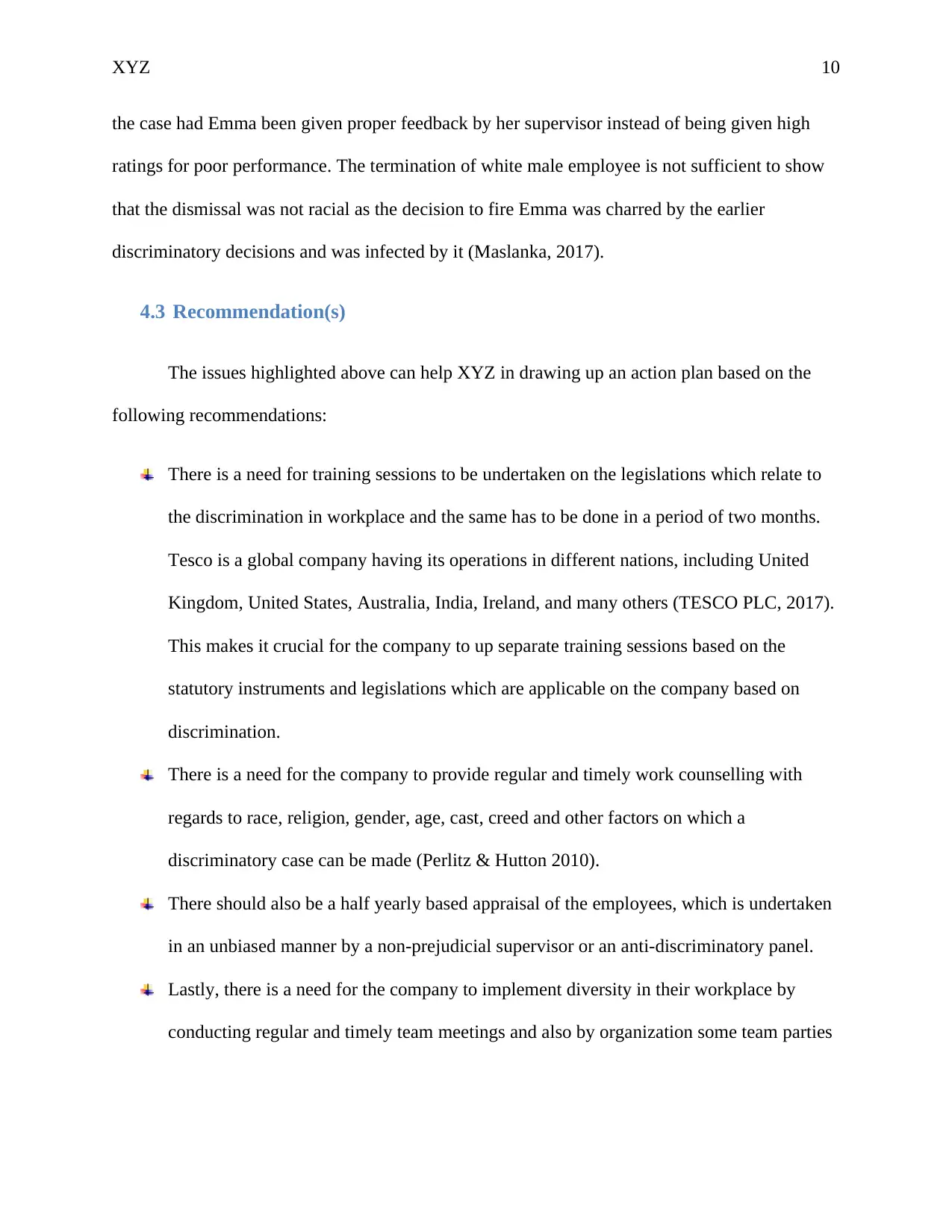
XYZ 10
the case had Emma been given proper feedback by her supervisor instead of being given high
ratings for poor performance. The termination of white male employee is not sufficient to show
that the dismissal was not racial as the decision to fire Emma was charred by the earlier
discriminatory decisions and was infected by it (Maslanka, 2017).
4.3 Recommendation(s)
The issues highlighted above can help XYZ in drawing up an action plan based on the
following recommendations:
There is a need for training sessions to be undertaken on the legislations which relate to
the discrimination in workplace and the same has to be done in a period of two months.
Tesco is a global company having its operations in different nations, including United
Kingdom, United States, Australia, India, Ireland, and many others (TESCO PLC, 2017).
This makes it crucial for the company to up separate training sessions based on the
statutory instruments and legislations which are applicable on the company based on
discrimination.
There is a need for the company to provide regular and timely work counselling with
regards to race, religion, gender, age, cast, creed and other factors on which a
discriminatory case can be made (Perlitz & Hutton 2010).
There should also be a half yearly based appraisal of the employees, which is undertaken
in an unbiased manner by a non-prejudicial supervisor or an anti-discriminatory panel.
Lastly, there is a need for the company to implement diversity in their workplace by
conducting regular and timely team meetings and also by organization some team parties
the case had Emma been given proper feedback by her supervisor instead of being given high
ratings for poor performance. The termination of white male employee is not sufficient to show
that the dismissal was not racial as the decision to fire Emma was charred by the earlier
discriminatory decisions and was infected by it (Maslanka, 2017).
4.3 Recommendation(s)
The issues highlighted above can help XYZ in drawing up an action plan based on the
following recommendations:
There is a need for training sessions to be undertaken on the legislations which relate to
the discrimination in workplace and the same has to be done in a period of two months.
Tesco is a global company having its operations in different nations, including United
Kingdom, United States, Australia, India, Ireland, and many others (TESCO PLC, 2017).
This makes it crucial for the company to up separate training sessions based on the
statutory instruments and legislations which are applicable on the company based on
discrimination.
There is a need for the company to provide regular and timely work counselling with
regards to race, religion, gender, age, cast, creed and other factors on which a
discriminatory case can be made (Perlitz & Hutton 2010).
There should also be a half yearly based appraisal of the employees, which is undertaken
in an unbiased manner by a non-prejudicial supervisor or an anti-discriminatory panel.
Lastly, there is a need for the company to implement diversity in their workplace by
conducting regular and timely team meetings and also by organization some team parties
Secure Best Marks with AI Grader
Need help grading? Try our AI Grader for instant feedback on your assignments.
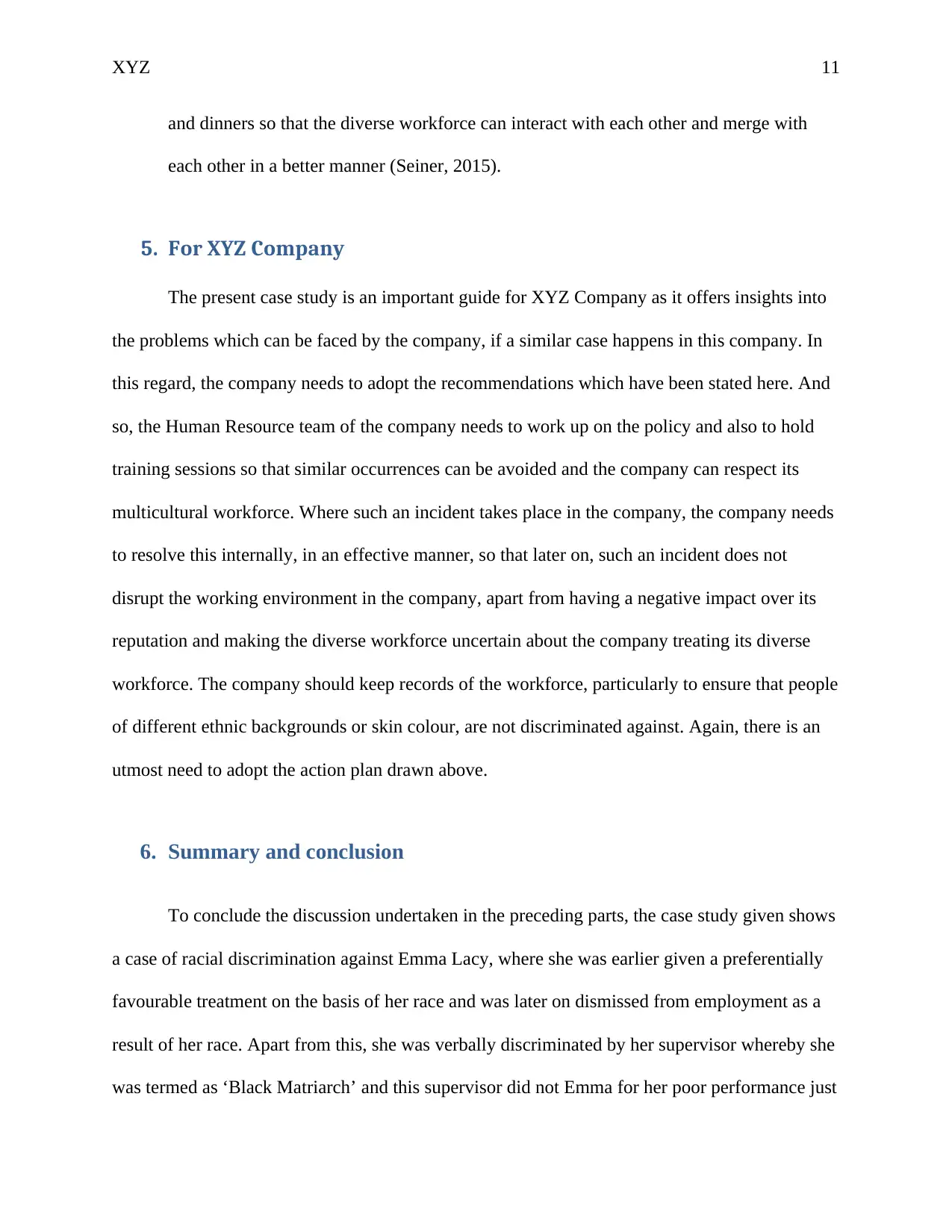
XYZ 11
and dinners so that the diverse workforce can interact with each other and merge with
each other in a better manner (Seiner, 2015).
5. For XYZ Company
The present case study is an important guide for XYZ Company as it offers insights into
the problems which can be faced by the company, if a similar case happens in this company. In
this regard, the company needs to adopt the recommendations which have been stated here. And
so, the Human Resource team of the company needs to work up on the policy and also to hold
training sessions so that similar occurrences can be avoided and the company can respect its
multicultural workforce. Where such an incident takes place in the company, the company needs
to resolve this internally, in an effective manner, so that later on, such an incident does not
disrupt the working environment in the company, apart from having a negative impact over its
reputation and making the diverse workforce uncertain about the company treating its diverse
workforce. The company should keep records of the workforce, particularly to ensure that people
of different ethnic backgrounds or skin colour, are not discriminated against. Again, there is an
utmost need to adopt the action plan drawn above.
6. Summary and conclusion
To conclude the discussion undertaken in the preceding parts, the case study given shows
a case of racial discrimination against Emma Lacy, where she was earlier given a preferentially
favourable treatment on the basis of her race and was later on dismissed from employment as a
result of her race. Apart from this, she was verbally discriminated by her supervisor whereby she
was termed as ‘Black Matriarch’ and this supervisor did not Emma for her poor performance just
and dinners so that the diverse workforce can interact with each other and merge with
each other in a better manner (Seiner, 2015).
5. For XYZ Company
The present case study is an important guide for XYZ Company as it offers insights into
the problems which can be faced by the company, if a similar case happens in this company. In
this regard, the company needs to adopt the recommendations which have been stated here. And
so, the Human Resource team of the company needs to work up on the policy and also to hold
training sessions so that similar occurrences can be avoided and the company can respect its
multicultural workforce. Where such an incident takes place in the company, the company needs
to resolve this internally, in an effective manner, so that later on, such an incident does not
disrupt the working environment in the company, apart from having a negative impact over its
reputation and making the diverse workforce uncertain about the company treating its diverse
workforce. The company should keep records of the workforce, particularly to ensure that people
of different ethnic backgrounds or skin colour, are not discriminated against. Again, there is an
utmost need to adopt the action plan drawn above.
6. Summary and conclusion
To conclude the discussion undertaken in the preceding parts, the case study given shows
a case of racial discrimination against Emma Lacy, where she was earlier given a preferentially
favourable treatment on the basis of her race and was later on dismissed from employment as a
result of her race. Apart from this, she was verbally discriminated by her supervisor whereby she
was termed as ‘Black Matriarch’ and this supervisor did not Emma for her poor performance just
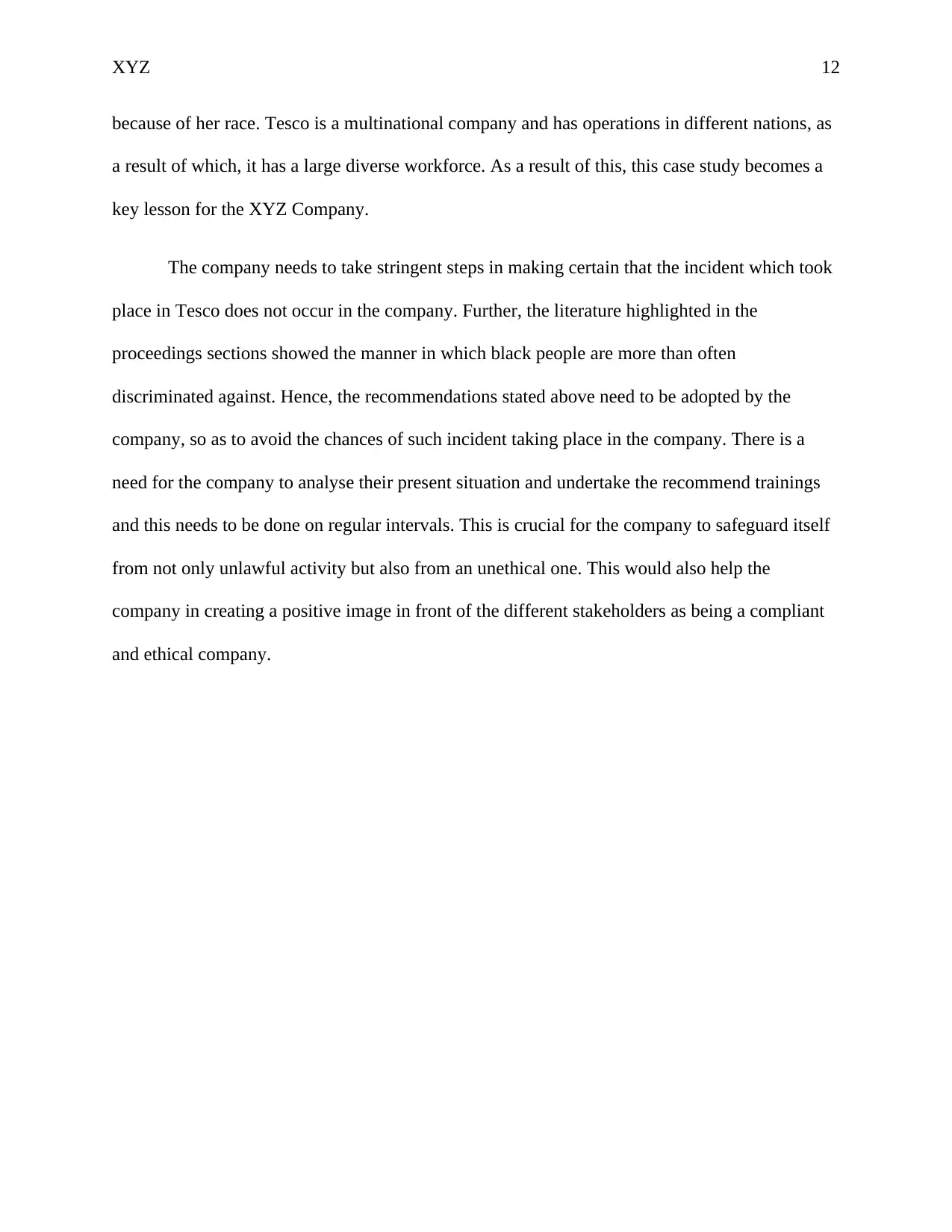
XYZ 12
because of her race. Tesco is a multinational company and has operations in different nations, as
a result of which, it has a large diverse workforce. As a result of this, this case study becomes a
key lesson for the XYZ Company.
The company needs to take stringent steps in making certain that the incident which took
place in Tesco does not occur in the company. Further, the literature highlighted in the
proceedings sections showed the manner in which black people are more than often
discriminated against. Hence, the recommendations stated above need to be adopted by the
company, so as to avoid the chances of such incident taking place in the company. There is a
need for the company to analyse their present situation and undertake the recommend trainings
and this needs to be done on regular intervals. This is crucial for the company to safeguard itself
from not only unlawful activity but also from an unethical one. This would also help the
company in creating a positive image in front of the different stakeholders as being a compliant
and ethical company.
because of her race. Tesco is a multinational company and has operations in different nations, as
a result of which, it has a large diverse workforce. As a result of this, this case study becomes a
key lesson for the XYZ Company.
The company needs to take stringent steps in making certain that the incident which took
place in Tesco does not occur in the company. Further, the literature highlighted in the
proceedings sections showed the manner in which black people are more than often
discriminated against. Hence, the recommendations stated above need to be adopted by the
company, so as to avoid the chances of such incident taking place in the company. There is a
need for the company to analyse their present situation and undertake the recommend trainings
and this needs to be done on regular intervals. This is crucial for the company to safeguard itself
from not only unlawful activity but also from an unethical one. This would also help the
company in creating a positive image in front of the different stakeholders as being a compliant
and ethical company.
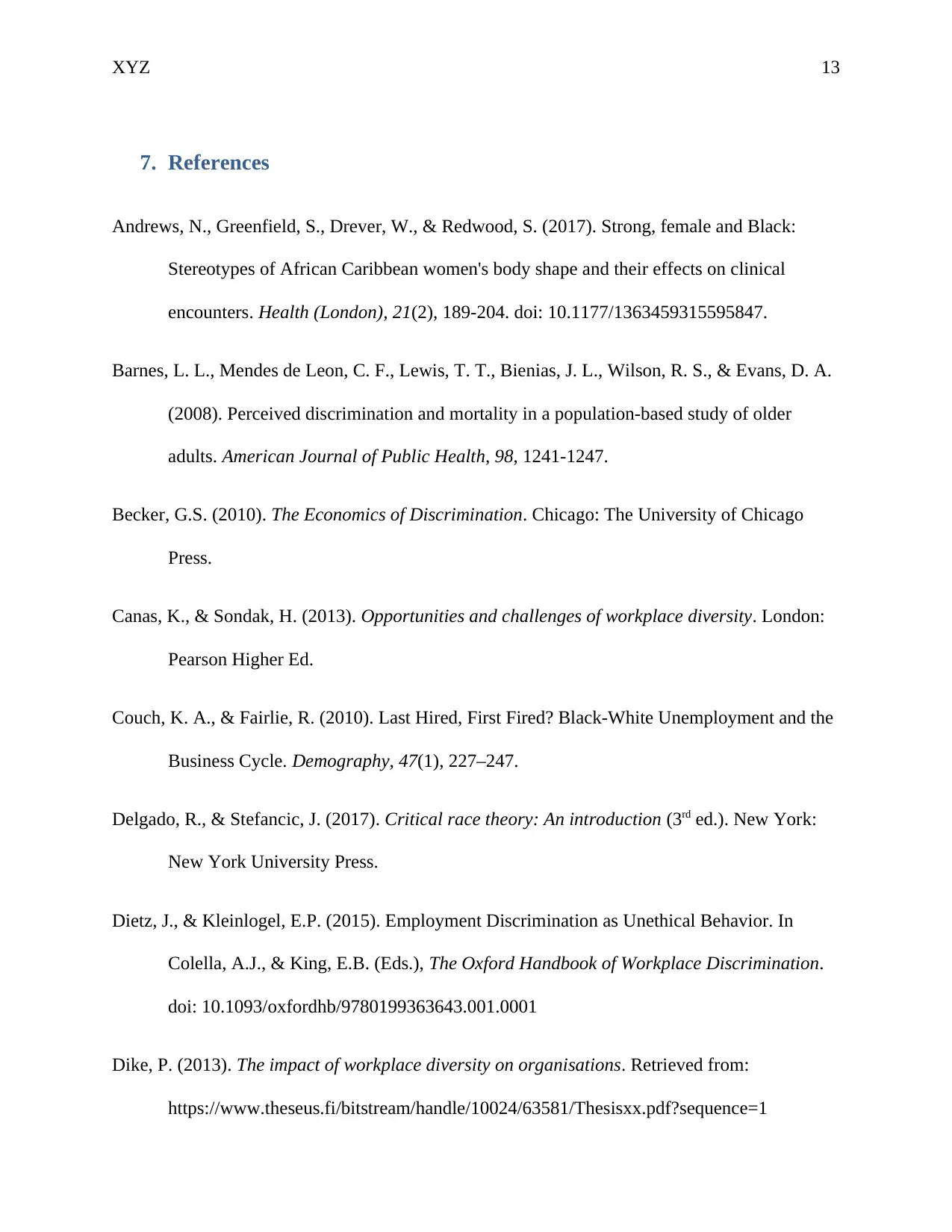
XYZ 13
7. References
Andrews, N., Greenfield, S., Drever, W., & Redwood, S. (2017). Strong, female and Black:
Stereotypes of African Caribbean women's body shape and their effects on clinical
encounters. Health (London), 21(2), 189-204. doi: 10.1177/1363459315595847.
Barnes, L. L., Mendes de Leon, C. F., Lewis, T. T., Bienias, J. L., Wilson, R. S., & Evans, D. A.
(2008). Perceived discrimination and mortality in a population-based study of older
adults. American Journal of Public Health, 98, 1241-1247.
Becker, G.S. (2010). The Economics of Discrimination. Chicago: The University of Chicago
Press.
Canas, K., & Sondak, H. (2013). Opportunities and challenges of workplace diversity. London:
Pearson Higher Ed.
Couch, K. A., & Fairlie, R. (2010). Last Hired, First Fired? Black-White Unemployment and the
Business Cycle. Demography, 47(1), 227–247.
Delgado, R., & Stefancic, J. (2017). Critical race theory: An introduction (3rd ed.). New York:
New York University Press.
Dietz, J., & Kleinlogel, E.P. (2015). Employment Discrimination as Unethical Behavior. In
Colella, A.J., & King, E.B. (Eds.), The Oxford Handbook of Workplace Discrimination.
doi: 10.1093/oxfordhb/9780199363643.001.0001
Dike, P. (2013). The impact of workplace diversity on organisations. Retrieved from:
https://www.theseus.fi/bitstream/handle/10024/63581/Thesisxx.pdf?sequence=1
7. References
Andrews, N., Greenfield, S., Drever, W., & Redwood, S. (2017). Strong, female and Black:
Stereotypes of African Caribbean women's body shape and their effects on clinical
encounters. Health (London), 21(2), 189-204. doi: 10.1177/1363459315595847.
Barnes, L. L., Mendes de Leon, C. F., Lewis, T. T., Bienias, J. L., Wilson, R. S., & Evans, D. A.
(2008). Perceived discrimination and mortality in a population-based study of older
adults. American Journal of Public Health, 98, 1241-1247.
Becker, G.S. (2010). The Economics of Discrimination. Chicago: The University of Chicago
Press.
Canas, K., & Sondak, H. (2013). Opportunities and challenges of workplace diversity. London:
Pearson Higher Ed.
Couch, K. A., & Fairlie, R. (2010). Last Hired, First Fired? Black-White Unemployment and the
Business Cycle. Demography, 47(1), 227–247.
Delgado, R., & Stefancic, J. (2017). Critical race theory: An introduction (3rd ed.). New York:
New York University Press.
Dietz, J., & Kleinlogel, E.P. (2015). Employment Discrimination as Unethical Behavior. In
Colella, A.J., & King, E.B. (Eds.), The Oxford Handbook of Workplace Discrimination.
doi: 10.1093/oxfordhb/9780199363643.001.0001
Dike, P. (2013). The impact of workplace diversity on organisations. Retrieved from:
https://www.theseus.fi/bitstream/handle/10024/63581/Thesisxx.pdf?sequence=1
Paraphrase This Document
Need a fresh take? Get an instant paraphrase of this document with our AI Paraphraser
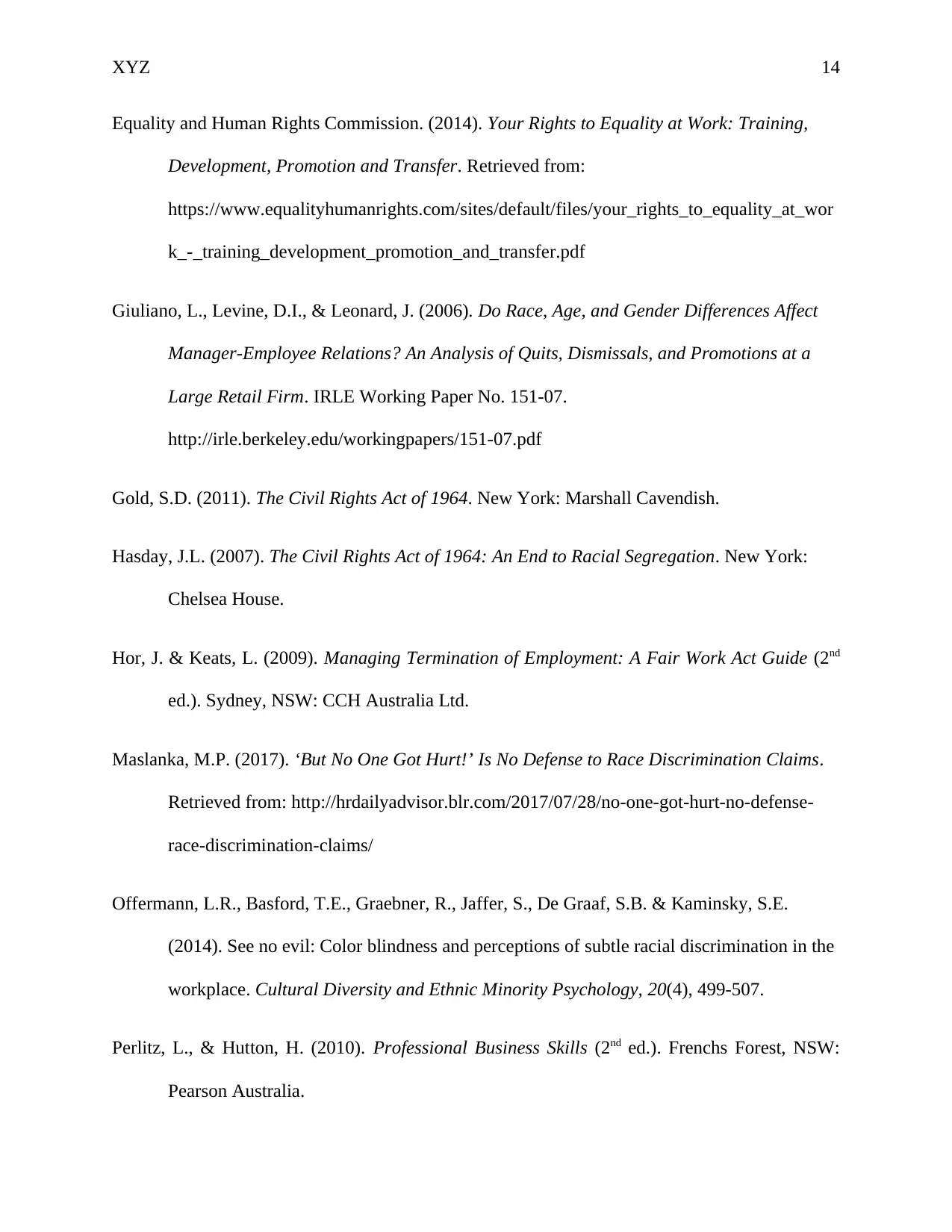
XYZ 14
Equality and Human Rights Commission. (2014). Your Rights to Equality at Work: Training,
Development, Promotion and Transfer. Retrieved from:
https://www.equalityhumanrights.com/sites/default/files/your_rights_to_equality_at_wor
k_-_training_development_promotion_and_transfer.pdf
Giuliano, L., Levine, D.I., & Leonard, J. (2006). Do Race, Age, and Gender Differences Affect
Manager-Employee Relations? An Analysis of Quits, Dismissals, and Promotions at a
Large Retail Firm. IRLE Working Paper No. 151-07.
http://irle.berkeley.edu/workingpapers/151-07.pdf
Gold, S.D. (2011). The Civil Rights Act of 1964. New York: Marshall Cavendish.
Hasday, J.L. (2007). The Civil Rights Act of 1964: An End to Racial Segregation. New York:
Chelsea House.
Hor, J. & Keats, L. (2009). Managing Termination of Employment: A Fair Work Act Guide (2nd
ed.). Sydney, NSW: CCH Australia Ltd.
Maslanka, M.P. (2017). ‘But No One Got Hurt!’ Is No Defense to Race Discrimination Claims.
Retrieved from: http://hrdailyadvisor.blr.com/2017/07/28/no-one-got-hurt-no-defense-
race-discrimination-claims/
Offermann, L.R., Basford, T.E., Graebner, R., Jaffer, S., De Graaf, S.B. & Kaminsky, S.E.
(2014). See no evil: Color blindness and perceptions of subtle racial discrimination in the
workplace. Cultural Diversity and Ethnic Minority Psychology, 20(4), 499-507.
Perlitz, L., & Hutton, H. (2010). Professional Business Skills (2nd ed.). Frenchs Forest, NSW:
Pearson Australia.
Equality and Human Rights Commission. (2014). Your Rights to Equality at Work: Training,
Development, Promotion and Transfer. Retrieved from:
https://www.equalityhumanrights.com/sites/default/files/your_rights_to_equality_at_wor
k_-_training_development_promotion_and_transfer.pdf
Giuliano, L., Levine, D.I., & Leonard, J. (2006). Do Race, Age, and Gender Differences Affect
Manager-Employee Relations? An Analysis of Quits, Dismissals, and Promotions at a
Large Retail Firm. IRLE Working Paper No. 151-07.
http://irle.berkeley.edu/workingpapers/151-07.pdf
Gold, S.D. (2011). The Civil Rights Act of 1964. New York: Marshall Cavendish.
Hasday, J.L. (2007). The Civil Rights Act of 1964: An End to Racial Segregation. New York:
Chelsea House.
Hor, J. & Keats, L. (2009). Managing Termination of Employment: A Fair Work Act Guide (2nd
ed.). Sydney, NSW: CCH Australia Ltd.
Maslanka, M.P. (2017). ‘But No One Got Hurt!’ Is No Defense to Race Discrimination Claims.
Retrieved from: http://hrdailyadvisor.blr.com/2017/07/28/no-one-got-hurt-no-defense-
race-discrimination-claims/
Offermann, L.R., Basford, T.E., Graebner, R., Jaffer, S., De Graaf, S.B. & Kaminsky, S.E.
(2014). See no evil: Color blindness and perceptions of subtle racial discrimination in the
workplace. Cultural Diversity and Ethnic Minority Psychology, 20(4), 499-507.
Perlitz, L., & Hutton, H. (2010). Professional Business Skills (2nd ed.). Frenchs Forest, NSW:
Pearson Australia.

XYZ 15
Sargeant, M. (2016). Age Discrimination in Employment. Oxon: Routledge.
Seiner, J.A. (2015). Employment Discrimination: Procedures, Principles, and Practice. New
York: Wolter Kluwer.
Settles, I.H., Buchanan, N.T., & Yap, S.C.Y. (2010). Race/Color Discrimination. In M. A.
Paludi, C. A. Paludi Jr., & E. DeSouza (Eds.), Praeger Handbook on Understanding and
Preventing Workplace Discrimination (133-156). Westport, CT: Praeger Publishers.
Stainback, K., & Tomaskovic-Devey, D. (2012). Documenting desegregation: Racial and gender
segregation in private sector employment since the Civil Rights Act. New York: Russell
Sage Foundation.
Tchibozo, G. (2010). Cultural and Social Diversity and the Transition from Education to Work.
London: Springer.
TESCO PLC. (2017). Our businesses. Retrieved from: https://www.tescoplc.com/about-us/our-
businesses/
White, G.B. (2015) Black Workers Really Do Need to Be Twice as Good. Retrieved from:
https://www.theatlantic.com/business/archive/2015/10/why-black-workers-really-do-
need-to-be-twice-as-good/409276/
Wilson, G. (2005). Race and job dismissal: African American/White differences in their sources
during the early work career. American Behavioral Scientist, 48, 1182-1199.
Sargeant, M. (2016). Age Discrimination in Employment. Oxon: Routledge.
Seiner, J.A. (2015). Employment Discrimination: Procedures, Principles, and Practice. New
York: Wolter Kluwer.
Settles, I.H., Buchanan, N.T., & Yap, S.C.Y. (2010). Race/Color Discrimination. In M. A.
Paludi, C. A. Paludi Jr., & E. DeSouza (Eds.), Praeger Handbook on Understanding and
Preventing Workplace Discrimination (133-156). Westport, CT: Praeger Publishers.
Stainback, K., & Tomaskovic-Devey, D. (2012). Documenting desegregation: Racial and gender
segregation in private sector employment since the Civil Rights Act. New York: Russell
Sage Foundation.
Tchibozo, G. (2010). Cultural and Social Diversity and the Transition from Education to Work.
London: Springer.
TESCO PLC. (2017). Our businesses. Retrieved from: https://www.tescoplc.com/about-us/our-
businesses/
White, G.B. (2015) Black Workers Really Do Need to Be Twice as Good. Retrieved from:
https://www.theatlantic.com/business/archive/2015/10/why-black-workers-really-do-
need-to-be-twice-as-good/409276/
Wilson, G. (2005). Race and job dismissal: African American/White differences in their sources
during the early work career. American Behavioral Scientist, 48, 1182-1199.
1 out of 15
Related Documents
Your All-in-One AI-Powered Toolkit for Academic Success.
+13062052269
info@desklib.com
Available 24*7 on WhatsApp / Email
![[object Object]](/_next/static/media/star-bottom.7253800d.svg)
Unlock your academic potential
© 2024 | Zucol Services PVT LTD | All rights reserved.
